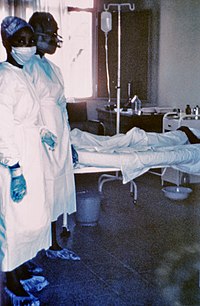
Photo from wikipedia
Ebola virus (EBOV) causes severe acute human disease with high lethality. Viremia is typical during the acute disease phase. However, EBOV RNA can remain detectable in immune-privileged tissues for prolonged… Click to show full abstract
Ebola virus (EBOV) causes severe acute human disease with high lethality. Viremia is typical during the acute disease phase. However, EBOV RNA can remain detectable in immune-privileged tissues for prolonged periods of time after clearance from the blood, suggesting EBOV may persist during convalescence and thereafter. Eliminating persistent EBOV is important to ensure full recovery of survivors and decrease the risk of outbreak re-ignition caused by EBOV spread from apparently healthy survivors to naive contacts. Here, we review prior evidence of EBOV persistence and explore the tools needed for the development of model systems to understand persistence.
Journal Title: Current opinion in virology
Year Published: 2017
Link to full text (if available)
Share on Social Media: Sign Up to like & get
recommendations!